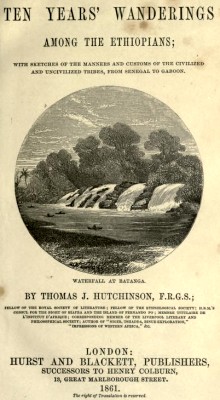
henry meredith : cane surfing in africa, 1812
| home | catalogue | history | references | appendix |
 |
surfresearch.com.au
henry meredith : cane surfing in africa, 1812 |
Dawson, Kevin : Swimming,
Surfing and Underwater Diving in Early Modern Atlantic Africa and the African
Diaspora.
Carina Ray and Jeremy
Rich, eds., Navigating African Maritime History
Research in Maritime
History book series,
Memorial University
of Newfoundland Press, 2009, pp. 81-116.
http://history.unlv.edu/faculty/dawson/Swimming & Surfing in Africa copy.pdf, viewed 10 April 2013.
Dawson notes that Apollonia is on the Gold Coast of West Africa.
A standard account
of canoe surf riding, where a suitable wave is selected and the crew and
when riding the canoe is controlled by trailing paddles.
As usual, the course
is a direct line to the beach.
There are a number
of similar accounts from Africa, as well as from India and across the Pacific.
In this case the
dugout canoes probably did not have outriggers.
Also see:
1823 John Adams : Surfboard
Riding on the West Coast, Africa.
1835 James Edward
Alexander :
West Africa.
1861 Thomas J. Hutchinson : Surfboard
Riding in Gabon, Africa.
1891 The Graphic
: Surf Boats, Ghana.
1923 Robert Rattray : Padua
at Lake Bosumtwi, Africa.
Dawson also notes several instances of the swimming skills of 'emmigrant' Africans (usually slaves), page 104, adjusted:
"When Africans were
carried throughout the Atlantic world, they and their descendants continued
to save the lives of drowning
whites.
(a) In 1805, the
Barbadian slaveholder Robert Haynes sent his three sons to school in Liverpool,
along with a slave named Hamlet
who “saved the life
of my son George”when he fell “overboard whilst landing at Liverpool.”
(b)A white clerk
“who could only swim a few strokes” slipped off a “ship’s gangway” in Baltimore
harbour and was pulled by “far out
in the harbour.”
Fortunately, his
enslaved friend Zamba, who was raised on the “south bank of the river Congo,
about two hundred miles from the
sea” and had become
“quite used to the water in Africa and could swim like a seagull,” dove
in and kept him afloat until men
in a rowboat could
haul him out.
Some accounts demonstrate
that members of the African diaspora possessed exceptional swimming skills.
(c) During a 1792
flood on St. Kitts, a biracial man dramatically saved a white woman from
a different sort of marine disaster.
“A Mrs.T, with her
house and family, was carried into the sea: she cried out, ‘Lord have Mercy
upon me.’
A Mulatto, hearing
her cries [swam]...after her, caught her hair and saved her, though she
was almost dead.”
(d) In another instance,
a Brazilian steamer ran aground and began to break apart, but fortunately
a black sailor named Simao “swam
through the furious
breakers” thirteen times to save as many passengers. (15)
(Footnote) 15
a. Robert Haynes,
The
Barbadian Diary of General Robert Haynes, 1787–1836
Medstead, Hants.,
1934, page 26;
b. Zamba, The
Life and Adventures of Zamba, an African Negro King; and His Experience
of Slavery in South Carolina
London,1847, pages
1 and 168-170;
c. Henry G. Adams
(ed.), God’s Image in Ebony: Being a Series of Biographical Sketches,
Facts, Anecdotes, etc., Demonstrative of
the Mental Powers
and Intellectual Capacities of the Negro Race, London, 1854, pages159-160;
d. John G. Clinkscales,
On
The Old Plantation: Reminiscences of His Childhood
Spartansburg, SC,
1916; reprint, New York, 1969, page 26;
and
Frederic W.N. Bayley,
Four
Year’s Residence in the West Indies, During the Years 1826,7,8, and 9,
London, 1833, page 486.
The sea breaks
with such violence along the coast of Apollonia, [Gold Coast] that it cannot
be approached without the utmost
danger...but
those who are acquainted with the art of paddling canoes, perform their
office with much dexterity.
They will go
off to vessels, and convey merchandize on shore with safety: when they
wish to display a proof of their skill, they can
conduct a canoe
on shore with surprizing velocity.
They watch the
sea when on the point of breaking, and every man betakes himself to steering;
which they perform by keeping the
flat part of
the paddle parallel to the canoe, and giving it a quick motion, making
nearly right angles with the canoe: when they have
got the canoe
on the summit of the sea, and when it is ready to break, this quick motion
of the paddle is discontinued, and it is kept
firmly in a parallel
position; when the canoe flies on shore with great rapidity.
The canoe must
be kept on a balance, and as straight a course as possible be observed;
otherwise it will overset.
 |
An Account of the Gold Coast of Africa with a Brief History of the African Company London, 1812. |

| home | catalogue | history | references | appendix |